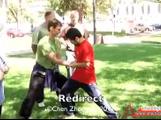Master Chen uses an umbrella to demonstrate structural requirement and power generation for taijiquan.
Presenter: Chen Zhonghua Length: 9 min. In: English Year: 2013 Difficulty:3/5 At:Daqingshan
“Taiji in the umbrella” Online Video Trailer
Previous post: Please Keep the Elbows In
Next post: There are no movements, only rotations!



{ 9 comments… read them below or add one }
Thanks for sharing this video. I can see “Form opens when energy is compresses to close, form close when energy is stretched to open” “形开劲合,形合劲开”there. When the spine compresses, the arms are pushed out. When the spine stretches, the arms are pulled in. Same for the umbrella, when the ring is compressed toward the top, it opens. When the ring is stretched towards the handle, it closes.
I have a question though.
In the video master Chen says that the spine must be erect, however Calvin mentioned the compression of the spine, and in exercises like push the wall, clearly the back is bent.
So -can- the spine ‘bend’ forward, or does compression of the spine mean strictly up/down compression?
I see the spine is erect not bent, it is compressd so that the hands are pushed up as in the double negative circle execise in the video. In the pushing the wall exercise, the spine is erect not bent, it actually stretches.
That clear up a lot of things actually. Thanks
Body parts can appear arched, but whether or not they are “bent” or “stretched” has to do with the two ends. Master Chen tells us the requirement in taiji is “Never bend, only stretch”. This relates to the concept of “lock two points”, not to whether or not something appears “bent” or arched. Whichever two points you are working with, let’s say top of head to base of spine, the two ends must lock (no move), then move the middle to “stretch”, making that particular relationship longer, without moving the head or tailbone, causing arching. “Bending” would be if you moved the head forward, to become longer, moving one of your locked points. So to “stretch” lock the two ends and move whats in the middle. Never bend.
There is a relativity issue there though. Like in push the wall, you already start in a curved fashion, so even if afterwards you lock the points(top and bottom for instance) and stretch, you already started, in a sense, ‘bent’.
I could’ve kept my back totally straight and stretched, or curved everything and stretched.
So in a way the principle its self does not establish a fiscal requirement, only a method, based on 2 referred points. Thats where my questions always come from.
My current belief is that the back is curved in this exercise, because in the push the wall ‘everything goes into that line’, the line being from the wall(front hand) to your foot.
But many of these concepts, in me, are still being born atm, so i may be totally mistaken.
Its one thing to believe in the Dao, and another to carry out the Dao.
Most of my puzzles have to do with the anatomy of things, and the structural body-development nature of each exercise, so its not just about the method its self, but the proper development path for an ideal body-alignment-structure.
Many thanks for your reply Bruce, I’m personally always fond of your comments.
Thank you Andre, I always enjoy reading and learning from everyone’s comments as well. In the “Push the Wall” video, the primary relationship and the “two locked points” are the front hand and rear foot. It is a way to practice “stretching” by arching and trying to create evenness throughout the arches, rather than getting localized power in any one part, which is our tendency. The wall and the floor, hand and foot, two locked points, cannot move within the confines of the training exercise, so we cannot “bend” (move the front hand), and can dedicate our effort to arching evenly, “stretching”, moving whats in the middle to become longer, and squeeze everything toward that line. It’s a very specific set of instructions to facilitate specific results.
The instructions in this video, are different, and have a different training focus. So we have to be careful not to try to apply one set of training parameters to other exercises, even if we think we see a relationship. One thing I like so much about Practical Method is that it trains the integrity and validity of physical actions by testing them, much the same way as a scientist might set up an experiment… repeatedly testing something to ensure the same result can be achieved regardless of what we think or how we feel about it. So the way we have to approach each exercise is similar. We are given specific instructions and theory that pertains to that specific “experiment”, and we have to be careful not to blend in processes from other “experiments”, to keep from tainting the results.
This is a perfect supplement to the recent Edmonton seminar and my corrections video. During the seminar Master Chen mentioned this video. It further explains what he was trying to teach me. Use the torso muscles not the arms. Power comes indirectly from the torso rather than directly from the arms.
As a new student, your comments are very helpful.